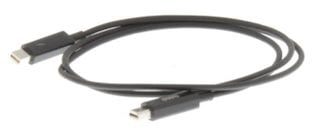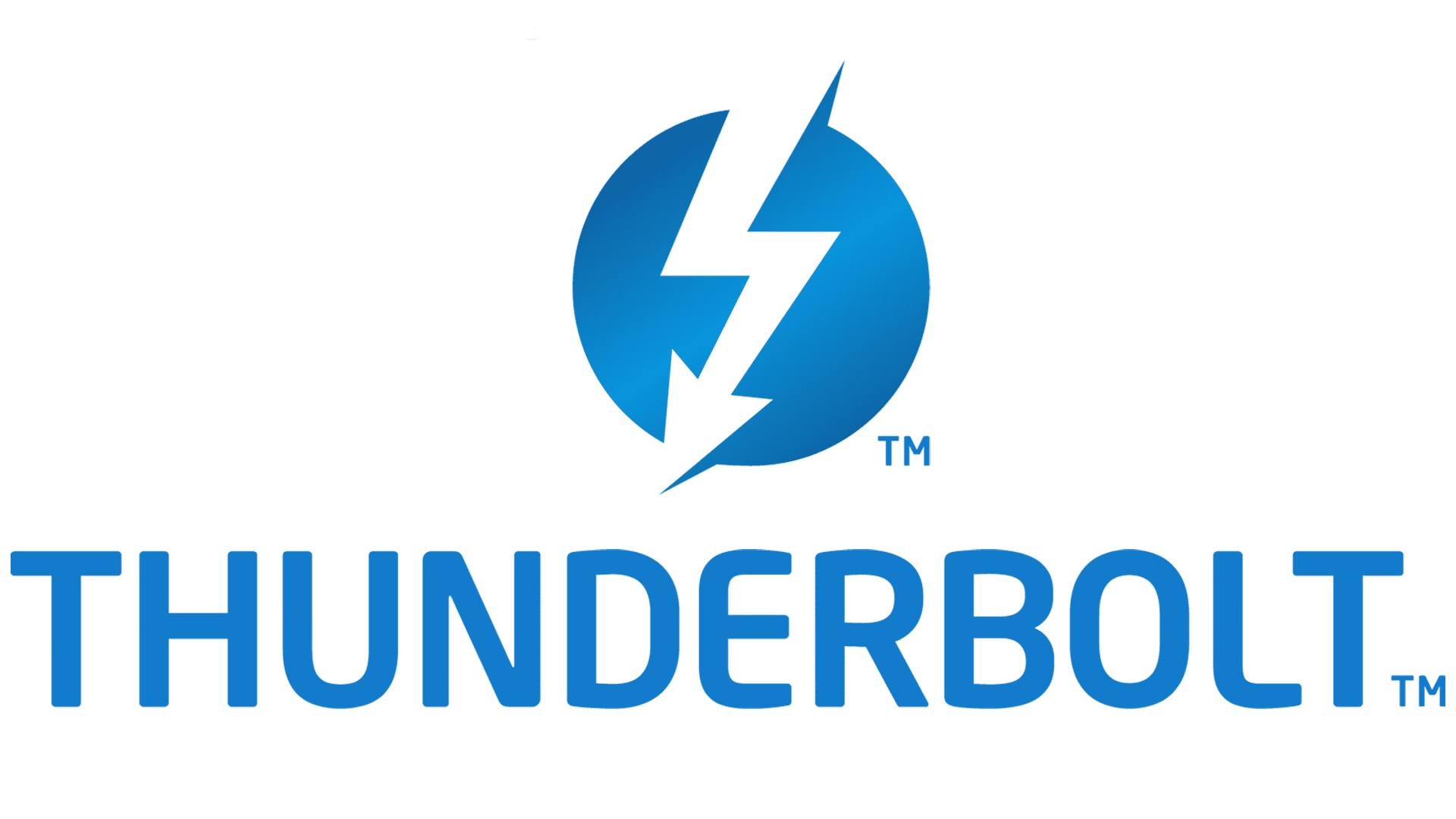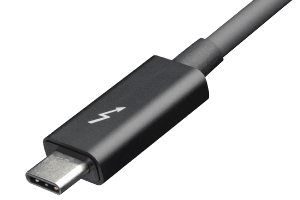
[Editor’s Note: For part two in our Thunderbolt 101 series, see What Thunderbolt 3 Speeds and Capabilities Mean for You]
Thunderbolt 3 is the most recent iteration of Thunderbolt, a hardware interface designed to connect multiple external peripherals to a computer at high data rates. This is the first in a series of educational articles to acquaint readers with the ins and outs Thunderbolt 3 (click here to see OWC CEO’s preview of Thunderbolt 3 gear at NAB 2016) and its promise for ultra-fast connectivity to peripherals, and today the Rocket Yard will provide a bit of history about Thunderbolt and the progress that has been made since it first appeared on the computing scene in 2011.
Light Peak
You may remember that the first Thunderbolt product came from Apple. In 2011, the MacBook Pro was updated with Thunderbolt ports. Before this time, the technology was more widely known as “Light Peak”, invented by Intel’s Silicon Photonics lab and expected to work over optical fibers. But Apple and Intel realized that the desired super-fast connectivity could be done at much less cost with traditional copper cables, and Apple quickly registered the name Thunderbolt for the technology. Since Intel had the primary intellectual property rights for the technology, Apple transferred the trademark to the chipmaker.
USB 3 vs. Thunderbolt
So, what exactly was the big deal about the original Thunderbolt? Well, up until that time there were a variety of different interfaces available for Macs and PCs, including the recently-introduced USB 3.0. Like USB 3.0, Thunderbolt was designed for faster connections to peripherals. But even the original Thunderbolt standard as implemented in the 2011 MacBook Pro had some advantages over USB 3.0. First, let’s talk about USB 3.0, what it could do, and why it became popular much faster than Thunderbolt.
Related: The History of USB … It’s Not Quite As Simple As 1, 2, 3
USB 3.0 introduced the SuperSpeed (SS) data transfer to the computing world, offering a transfer speed of up to 5 gigabits/second (Gbit/s). That, and the fact that USB 3.0 uses full-duplex transfers (transferring data in both directions simultaneously), gave USB 3.0 about a 20-fold theoretical bandwidth advantage over USB 2.0.
For those computers that shipped with USB 3.0 ports, there was one major advantage over Thunderbolt devices — the USB 3.0 ports were backward-compatible with USB 2.0 devices, meaning that new computers could still work with older USB 2.0 peripherals like printers and hard drives while owners waited for USB 3.0 peripherals to appear on the market.
The USB 3.1 specification was announced in 2013, bumping the top USB transfer speeds up to 10 Gbit/s (called USB 3.1 Gen 2)— exactly the same transfer speeds as the original Thunderbolt devices. And with the USB 3.1 spec, separately came a new connector type called USB-C. This is the connector that’s used for both power and data on the 12-inch Retina MacBook. (Note: For more information on the difference between USB 3.0 and USB 3.1, please read this article.)
Thunderbolt speeds
So with USB data transfer speeds roughly in the same ballpark as Thunderbolt around 2013, what are the advantages of Thunderbolt over USB?
First, up to six devices could be daisy-chained from one Thunderbolt port. The initial ports are virtually identical to Apple’s Mini DisplayPort and, in fact, use an identical connector. Since Thunderbolt can also transfer up to 10W of power, many peripherals can be bus-powered — that is, they don’t need to be plugged into a separate outlet. The most USB can handle is about 4.5W of power.
One of the biggest advantages is that Thunderbolt’s underlying technology made the idea of a Thunderbolt dock possible — a box that could use one Mac Thunderbolt port and provide the user with a variety of ports including HDMI or DVI video, FireWire, Ethernet, USB 3.0 and audio input/output. OWC was among the pioneers of Thunderbolt docks, with the OWC Thunderbolt 2 Dock.

While USB 3.1 Gen 2 put USB into the same data transfer speed range as Thunderbolt, Intel and other companies weren’t sitting still. Thunderbolt 2 was first introduced in Apple products in 2013’s MacBook Pro, aggregating two 10 Gbps channels and doubling transfer speeds to 20 Gbps. That means that Thunderbolt 2 can easily drive a 4K video monitor or a pair of QHD (2560 x 1440 pixel) monitors.
Thunderbolt 2 uses the same Mini DisplayPort connector as the original Thunderbolt, and is currently in use on every Mac manufactured with the exception of the 12-inch Retina MacBook. Of course, Intel and others continue to innovate…
Thunderbolt 3
Thunderbolt 3 is likely to be announced on any Mac products that are released in 2016 and into the future. Developed by Intel and released in 2015, Thunderbolt 3 does away with the Mini DisplayPort connector, instead adopting the USB-C connector, which unfortunately causes incompatibility with Thunderbolt 2.
Intel’s Thunderbolt 3 controller provides transfer speeds of up to 40 Gbps (with the correct cables) and allowing a single computer to drive a pair of 4K video monitors at 60 frames per second.
As I mentioned, Apple hasn’t announced any Thunderbolt 3 products at this point, but there’s still enough time for the company to introduce new or upgraded products with the interface. What adds to the possibility of Thunderbolt 3 Macs is that Intel’s Skylake architecture chipsets provide support for the interface. Oddly enough, there are only two Apple devices that are currently using the Skylake chipset, the iMac which Apple shipped with Thunderbolt 2 and one which doesn’t currently support Thunderbolt — the 12-inch Retina MacBook.
Thunderbolt’s slow rise
For quite a while, the only major computer manufacturer that used Thunderbolt or Thunderbolt 2 was Apple. As a result, there wasn’t the same rush to market with Thunderbolt peripherals as there was for USB 3.0 products. Thunderbolt also faced some challenges in the computer marketplace.

Initially there were debates about optical (fiber optic) Thunderbolt vs. copper Thunderbolt that resulted in delays in the manufacture of both computers and peripherals. Once those disagreements were ironed out and copper became the transfer medium of choice.
Apple being one of the only computer makers standing behind Thunderbolt in the early years, along with the relative high cost for Thunderbolt peripherals and accessories was a hindrance in the beginning.
The low cost of USB peripherals coupled with faster and faster versions of USB didn’t help speed up the adoption of Thunderbolt. But Thunderbolt 3’s use of the USB Type-C connector and the fact that one computer port will now be able to support 40 Gbit/s data transfer and fast charging, plus support DisplayPort, PCIe, and the fastest USB specification, is making it increasingly attractive to PC manufacturers other than Apple.
Laptops: The real future for Thunderbolt 3
Where Thunderbolt 3 can really shine is in laptop computers. The USB-C connector allows for very thin designs, and the speed could make it possible for a laptop to drive an external graphics accelerator for really fast gaming or video work…if such a graphics accelerator peripheral is released by a hardware vendor.
While Apple hasn’t officially announced Thunderbolt 3 support for upcoming Macs, it’s very likely that the company that supported the interface standard in its infancy will embrace it as a mature technology. Other PC manufacturers, including HP, Dell, MSI, Asus, Razer, and Acer, are all featuring Thunderbolt 3 in their 2016 product lines.
For Part 2 in this series, please visit eshop.macsales.com/blog/37294-tech-101-what-thunderbolt-3-speeds-and-capabilities-mean-for-you








Hello! I have no Thunderbolt in my Mac Pro mid 2012. It really sucks. I have USB 3.0- card but not the speed. The computer is too old and slow. But expensive was it in 2013. It is whining a lot and I am disturbed by it.
Hi –
Yeah, that’s one of the reasons I’ve never been a fan of the Mac Pro. Too expensive and outdated too quickly. Instead, I buy the 27-inch iMacs and keep them for three years; by the end of the three years, they’re really showing their age in terms of slowness. The latest iMacs are virtually silent, too, and having a Thunderbolt 2 port on them provides a lot of flexibility. Can’t wait to see one with Thunderbolt 3!
Steve
Thanks for your answer! There is an black cylinder too, the new Mac Pro, but I guess that it isn’t a big seller with prizes beginning at 8 500 US Dollars, 28 000 in Swedish money. I don’ t want it even if I could afford it.
Well it should be 3 500 dollars…
So if TB3 is using a USB-C connector will both USB-C and TB3 chipset be able to differentiate between the two protocols? How will consumers know the correct cable/connectors to purchase?
Hi, Roger –
From what I understand, the chipsets will easily be able to select the proper speeds based on what’s on the other end of the cable. Hook up a USB 3.0/3.1 external HDD to a TB3/USB-C port and it will downgrade to USB speeds and capabilities. Link up a daisy chain of Thunderbolt 3 devices and it “knows” to go full speed. For the most part, regular copper USB-C cables will work well with both USB 3.0/3.1 devices and Thunderbolt 3, although T3 won’t be at full speed without one of the more expensive “active” Thunderbolt 3 cables.
Companies like MacSales.com are very good about letting users know what devices and cables are compatible; most likely T3 drives and monitors will come with an active T3 cable or at least a recommendation to purchase one.
Hope this helps,
Steve
When OWC Thunderbolt 3 Dock?
When Thunderbolt 4?
Note: Thunderbolt 4 required to new 5K Apple display.
I’m guessing that it would be another two years or so until we see Thunderbolt 4 in general release, and to be honest with you I don’t think Apple’s coming out with a 5K standalone monitor. Since Thunderbolt 4 would also have the throughput to drive an 8K display – and that’s the next generation resolution for professional video – why not just bypass the oddball 5K resolution (although it’s great on the iMac) and make the leap to 8K?
Steve
Actually, the ultimate resolution will be 16K.
But Apple should release a brand new 4K or 5K Thunderbolt Display ASAP, with Thunderbolt 3, USB 3.1 Type-C (reversible) generation 2 and SDXC with extra pins supporting maximum read/write speed (300 MB/s).
“Oddly enough, the only Apple device that’s currently using a Skylake chipset is the only one that doesn’t currently support Thunderbolt — the 12-inch Retina MacBook.” Doesn’t the 27″ iMac also use Skylake CPUs?
You are absolutely correct, Brad, and it shows that I didn’t have enough coffee while writing this post in front of a 27-inch 5K Retina display iMac running the 4GHz Skylake quad-core processor. Thanks for pointing that out!
Steve